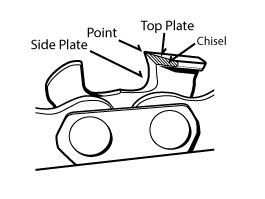Sharpening a saw requires focusing on all the cutting surfaces and consistent filing motions.
My last article covered the necessary tools for sharpening a chainsaw. This article will cover the right techniques and schedule for sharpening to ensure safe and efficient cutting.
All the time and money you spent on sharpening and the tools associated with it will be for naught if you file too deep or insufficiently, at the wrong angle, or unevenly. Now, if your cutters and rakers are all showing about the same amount of wear, then sharpening is easy. Just apply the same amount of force over the same amount of time to each cutter and raker, and in no time your chain should be good and sharp.
That can be easier said than done if you are filing by hand, and especially if you switch filing hand to sharpen the left or right facing cutters. You will know your technique is uneven when your saw cuts down through a log at an angle or a curve rather than straight. If the saw is cutting to the left rather than straight down, then you need to apply more force or increase the number of strokes when filing the right facing cutters to get them all evenly filed.
Along with keeping the cutters even, it is important to hit all the cutting surfaces when filing including the side plate, the top plate, and the point.
The side plate should be nearly vertical with a slight curve to it. If it is starting to look like a hook, then you need to file the point back a bit. The point needs to be distinct, but not too severe. A rounded off point or no point will reduce the cutting efficiency of the blade.
The top plate is the cutting surface located under the top of the cutter and is perpendicular to the direction the chain spins. Many of the manufacturers of chains today scribe the correct filing angle into the top of the cutter. Along with that angle, the chisel angle for the top plate (or the angle from the top of the plate downward) needs to be about 45 degrees.
When sharpening, it is best to hit all these surfaces at once rather than trying to sharpen each one individually. Having the right sized file will make applying even force on all these cutting surfaces pretty easy. The key is to keep in mind all of the areas you want to file at once, and deliver your strokes to cover them all.
I encourage you to test your filing work out before engaging in hours of cutting. It may turn out that the blade isn’t as sharp as you would like it or is not cutting straight. And practice filing whenever you can so that you can spend less time on it when you need a sharpened saw fast.
The frequency with which a blade needs to be sharpened can be summed up by four words: when it is dull. To make your cutting easier and more efficient, I suggest sharpening on a regular basis. The reasoning behind that is it is easier to keep a nearly sharp chain sharp than it is to sharpen a very dull blade.
Sharpening on a regular basis can vary depending on how often you are cutting, for how long, and what kinds of trees you are cutting. The wood of some trees will dull your chain faster than others, and of course cutting into the soil or rocks will adversely affect the sharpness of your blade.
A good rule of thumb is to sharpen your chain every time you stop to fill up with gas and oil. This may seem excessive to some, but has benefits on a couple of fronts. First, filing at this frequency will require only a small amount of work to bring your chain back up to optimum cutting performance. Second, this provides a short breather between continuous cutting and you will most likely return to work a bit refreshed.
Ultimately, a sharp chain cuts easier and therefore requires less effort out of you. That way you can get more work done and will encounter fewer fatigue related accidents.
